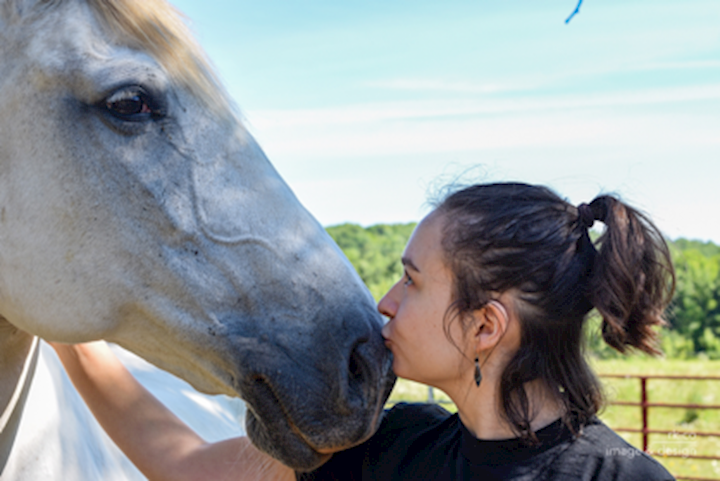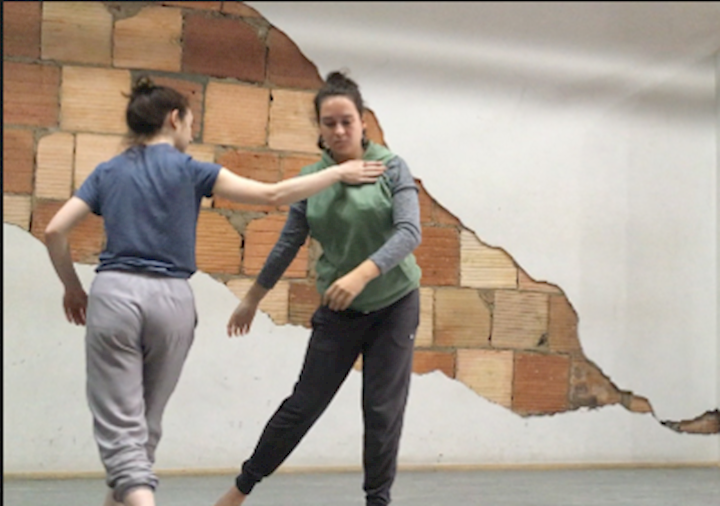I have spent much of my dance career inside the mainstream of contemporary dance, first in Seattle and for the past 29 years in NYC, but simultaneously adventurously pursuing an interest in site-specific performance. Then, in 1998 I created a trilogy of site works for dancers and horses, and never looked back. My company, The Equus Projects, is comprised of highly skilled dancers who are also trained in Natural Horsemanship. With The Equus Projects I have created well over 50 performance works with horses in communities throughout the States and in Europe, including commissioned works for Bates Dance Festival and the NYC River to River Festival. Former faculty at the Juilliard School and the Ailey American Dance Center, I continue to teach in NYC, offering monthly Dance Differently Research Labs. The foundation of all Equus teaching and choreographic work is a practice of Physical Listening, a somatic approach to communication and creative process, devised directly from Equus Projects' integration of dance and horsemanship. During the seclusion of the COVID-19 pandemic, I have been writing a book about The Equus Project and its unique journey out of the dance studio and into dusty arenas and pastures. Here, I consider “Improvisation and the Specificity of the Ask”.
I think it is fair to say that most dancers who love to improvise enter duet dialogues with the assumption that the shared objective is to just move together. Enough said. The engagement is about pleasure discovering in the moment. We figure out who leads and who follows as we are moving.
An arm draped over my shoulder, accompanied by a gentle nudge… If my improvisation partner offers a movement proposition, I join, possibly suggest a variation. I pay attention to the point of contact, body part, amount of weight I am receiving, noticing where the contact moves. No time to think about what happens next. Before any single thought crystalizes, we are on to the next moment.
Moving without physical contact, our cues are mostly visual. We catch a glimpse of another mover, steal fragments of that movement. Inside that borrowing process, I notice the distance between bodies and even the shape of that space. I notice body positioning, the texture of movement or its phrasing. Is it fast or slow, jagged or smooth, constrained or flowing? I notice without judgement or opinion but just borrowing fleeting fragments, trying them on. I notice repetitions and rhythmic patterns that emerge. I like to try and remember or log these pieces of kinetic information. I use these logged fragments as anchors, movement I return to in order to remind my partner that we are spontaneously creating a shared language.
With a perceptive and willing partner, those shared anchors emerge easily. We tacitly agree to use them as markers and gradually we are creating a shared language. I should mention that even in the most dynamic improvisations, those shared markers are interspersed with lots of rummaging about for the next moment of crystalized connection.
No need to think about why I make any one movement proposition. Anything can mean anything. I do not have to think about what my movement is saying or asking of my fellow mover or movers. The alpha dynamics of these encounters never occurred to me – except perhaps with a partner that tends to dominate, hijacking an idea and immediately creating a personal variation or simply leading all the time.
Until I began working with horses, I never thought about alpha dynamics or the specifics of the ASK. With an equine partner, the ASK determines the content of the conversation.
When my dancers and I began training in Natural Horsemanship ground skills, we brought our improvisation skills into the equine arena: Multi-focused noticing, shaping the space between moving bodies, remaining adaptable, absorbing the energetic feel of the animal. These skills served us well. We were practicing a kind of spatial and energetic mirroring that clearly attracted the horse’s attention, even at a great distance.
Seasoned horse people were fascinated by how easy it was for us to get the animal’s attention – a momentary, flicker of curiosity. “Human moving in an unfamiliar way.”
I noticed that if I stopped this mirroring process at just the right moment, if I dropped my agenda and softened my attention, often the horse would come closer. Sometimes if I repeated this process of engaging and softening and then just walk away from the horse, I might find a horse following me. Beginners luck! I had no idea why this was happening.
Not quite mirroring, surely not imitation, I called this dance of shaping space between, aligning bodies and mirroring energy sponging.
Practicing sponging in the studio, I assigned one mover as the animal or prime mover and the other mover as the sponger. We found that the sponger was doing a kind of spatial and energetic tracking that would look as if as the bodies were moving together but not actually imitating or doing the same activity. The sponging became a kind of visceral unison.
I wanted the follower to step away from the conventions of imitating positioning of the arms and legs. So, I asked for the sponger to just follow her partner’s pelvis, following from the side or behind, eyes glued to that low center of gravity. One pelvis tracking on another. Now, now, now. Follow no matter what. The follower has no time to think, or fix or refine. Pure survival mode. I called this form of following tracking.
There is a kind of ruthlessness to these sponging and tracking exercises. The lead mover has all the power. Only one dancer in this duet has a conscious vested interest in creating a movement dialogue.
Stripping away our dancer assumptions, we initiate the possibility of an equine dialogue.
Horses are tremendously sensitive animals, very attuned to our human energy or intention. They know when you have entered the pasture and can sense if you are just sharing space or entering with the intention of haltering them. They read intention. With a horse, sponging and tracking can become a form of asking for attention.
Try this with a human partner and surely the result would be the same. At some point animal or human would eventually ask “What do you want?”
And Now?
In the midst of COVID-19, we have gained the unexpected gift of time. Those of us who are not on the front lines keeping our hospitals and mail systems running are at home with time on our hands: Time to pay attention in ways that our rushed lives might not have allowed in the past.
Physical Listening is a way of being in relationship that requires you to take the time to notice how your partner is responding. In our social distancing world, perhaps try this with a pet: With a dog or cat, try just sitting or lying next to them in exactly the same position. Don't pat them or talk to them. Just be there. Wait. If they move, move with them. Keep thinking about just being with rather than hoping for them to pay attention. I am pretty sure they will notice. We are masters of making things happen. Try not to make something happen. Instead, create an If…Then game: If you move your whiskers, I will wiggle my right wrist. If you move your ear, I move my shoulders, Right ear, right shoulder, etc. Notice how they respond!
I am interested in how Physical Listening plays out with other humans. Have a conversation without checking your phone for messages. Ask a question and resist the temptation to add any opinion or commentary. I have spent lovely time on the phone with dear friends and tried to just listen. No additions, no opinions, no commentary.

